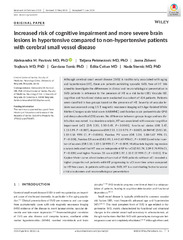Приказ основних података о документу
Increased risk of cognitive impairment and more severe brain lesions in hypertensive compared to non-hypertensive patients with cerebral small vessel disease
| dc.creator | Pavlovic, Aleksandra M. | |
| dc.creator | Pekmezovic, Tatjana | |
| dc.creator | Trajkovic, Jasna Zidverc | |
| dc.creator | Tomic, Gordana | |
| dc.creator | Cvitan, Edita | |
| dc.creator | Sternic, Nada | |
| dc.date.accessioned | 2023-02-09T13:40:30Z | |
| dc.date.available | 2023-02-09T13:40:30Z | |
| dc.date.issued | 2018 | |
| dc.identifier.issn | 1751-7176 | |
| dc.identifier.uri | https://onlinelibrary.wiley.com/doi/abs/10.1111/jch.13357 | |
| dc.identifier.uri | http://rfasper.fasper.bg.ac.rs/handle/123456789/5029 | |
| dc.description.abstract | Although cerebral small vessel disease (SVD) is traditionally associated with aging and hypertension (HT), there are patients exhibiting sporadic SVD, free of HT. We aimed to investigate the differences in clinical and neuroradiological presentation in SVD patients in reference to the presence of HT as a risk factor (RF). Vascular RF, cognitive and functional status were evaluated in a cohort of 424 patients. Patients were classified in two groups based on the presence of HT. Severity of vascular lesions was assessed using 1.5 T magnetic resonance imaging with Age-Related White Matter Changes scale total score (tARWMC) and Fazekas scale periventricular (PV) and deep subcortical (DS) scores. No difference between groups in age and sex distribution was noted. In univariate analysis, HT was associated with vascular cognitive impairment (vCI) (OR 2.30, 1.53-3.45, P < 0.0001), functional status (OR 1.47, 1.11-1.95, P = 0.007), depression (OR 2.13, 1.23-3.70, P = 0.007), tARWMC (OR 1.10, 1.05-1.16 95% CI, P < 0.0001), Fazekas PV score (OR 1.34, 1.08-1.67 95% CI, P = 0.008), Fazekas DS score (OR 1.95, 1.44-2.63 95% CI, P < 0.0001) and total number of lacunes (OR 1.10, 1.02-1.18 95% CI, P = 0.009). Multivariate logistic regression analysis indicated that HT was an independent RF for vCI (OR 1.74, 1.09-2.76 95% CI, P = 0.020) and higher Fazekas DS score (OR 1.57, 1.11-2.22 95% CI, P = 0.011). The Kaplan-Meier curve of estimates of survival of SVD patients without vCI revealed a higher proportion of patients with HT progressing to vCI over time when compared to HT-free cases. In patients with sporadic SVD, HT is a contributing factor to worse clinical outcomes and neuroradiological presentation. | |
| dc.language | en | |
| dc.publisher | Wiley | |
| dc.rights | openAccess | |
| dc.rights.uri | https://creativecommons.org/licenses/by/4.0/ | |
| dc.source | The Journal of Clinical Hypertension | |
| dc.subject | hypertension | |
| dc.subject | small vessel disease | |
| dc.subject | vascular cognitive impairment | |
| dc.subject | white matter hyperintensities | |
| dc.title | Increased risk of cognitive impairment and more severe brain lesions in hypertensive compared to non-hypertensive patients with cerebral small vessel disease | |
| dc.type | article | en |
| dc.rights.license | BY | |
| dc.citation.epage | 1265 | |
| dc.citation.issue | 9 | |
| dc.citation.spage | 1260 | |
| dc.citation.volume | 20 | |
| dc.identifier.doi | 10.1111/jch.13357 | |
| dc.identifier.fulltext | http://rfasper.fasper.bg.ac.rs/bitstream/id/9918/bitstream_9918.pdf | |
| dc.type.version | publishedVersion |


